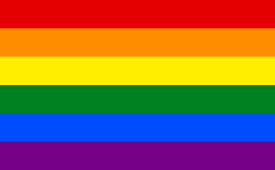Sexual diversity
| Part of a series on |
| Lesbian, gay, bisexual, and transgender (LGBT) people |
|---|
 |
|
|
Gender and sexual diversity (GSD), or simply sexual diversity, is a term used to refer to all the diversities of sex characteristics, sexual orientations and gender identities, without the need to specify each of the identities, behaviors, or characteristics that form this plurality.[1][2][3][4]
Overview
In the Western world, generally simple classifications are used to describe sexual orientation (heterosexuals, homosexuals and bisexuals), gender identity (transgender and cisgender), and related minorities (intersex), gathered under the acronyms LGBT or LGBTI (lesbian, gay, bisexual, transgender/transsexual people, and sometimes intersex people); however, other cultures have other ways of understanding the sex and gender systems.[5][6][7] Over the last few decades, some sexology theories have emerged, such as Kinsey theory and queer theory, proposing that this classification is not enough to describe the sexual complexity in the human beings and, even, in other animal species.[8]
For example, some people may feel an intermediate sexual orientation between heterosexual and bisexual (heteroflexible) or between homosexual and bisexual (homoflexible). It may vary over time, too, or include attraction not only towards women and men, but to all the spectrum of sexes and genders (pansexual). In other words, within bisexuality there exists a huge diversity of typologies and preferences that vary from an exclusive heterosexuality to a complete homosexuality (Kinsey scale).[9]
Sexual diversity includes intersex people, those born with a variety of intermediate features between women and men.[10] It also includes all transgender and transsex identities which do not frame within the binary gender system and, like sexual orientation, may be experienced in different degrees in between cisgender and transsexuality, such as genderfluid people.[11]
Lastly, sexual diversity also includes asexual people, who feel disinterest in sexual activity;[12] and all those who consider that their identity cannot be defined, such as queer people.
Socially, sexual diversity is claimed as the acceptance of being different but with equal rights, liberties, and opportunities within the Human Rights framework. In many countries, visibility of sexual diversity is vindicated during Pride Parades.[13]
See also
References
- ↑ Sexual and gender diversity. Rutgers. For sexual and reproductive health and rights.
- ↑ (in Portuguese) Diversidade Sexual e a Cidadania LGBT. Governo do Estado de São Paulo. Secretaria da Justiça e da Defesa da Cidadania. 2014.
- ↑ Meyer, Elizabeth J. (2010). Gender and Sexual Diversity in Schools. Springer Science & Business Media. ISBN 978-90-481-8558-0.
- ↑ FAQ on health and sexual diversity: The basics. World Health Organization. 2016.
- ↑ Kalra, G; Gupta, S; Bhugra, D (2010). "Sexual variation in India: A view from the west". Indian J Psychiatry. 52: S264–8. doi:10.4103/0019-5545.69244. PMC 3146184. PMID 21836691.
- ↑ Epprecht, Marc; Nyeck, S. N (2013). Sexual Diversity in Africa: Politics, Theory, and Citizenship. McGill-Queen's University Press. ISBN 978-07735-4187-0.
- ↑ Gender diversity in Indonesia: Sexuality, Islam and queer selves. 2010.
- ↑ Roughgarden, Joan (Director) (2008). Sexual Diversity in the Animal Kingdom.
- ↑ Beyond Heterosexual, Bisexual, and Homosexual: A Diversity in Sexual Identity Expression. Archives of Sexual Behavior. 2016.
- ↑ Un cuerpo, mil sexos: intersexualidades (in Spanish). Topia. 2010. ISBN 978-987-1185-42-9.
- ↑ Theorising Gender Diversity: Current trans, future directions. University of Huddersfield. 2013.
- ↑ Carrigan, Mark; Gupta, Kristina; Morrison, Todd G. (2015). Asexuality and Sexual Normativity: An Anthology. Routledge. ISBN 978-0-415-73132-4.
- ↑ Pride Weekend events celebrate gender and sexual diversity in Oxford. The Daily Mississippian. 17 may 2017.
